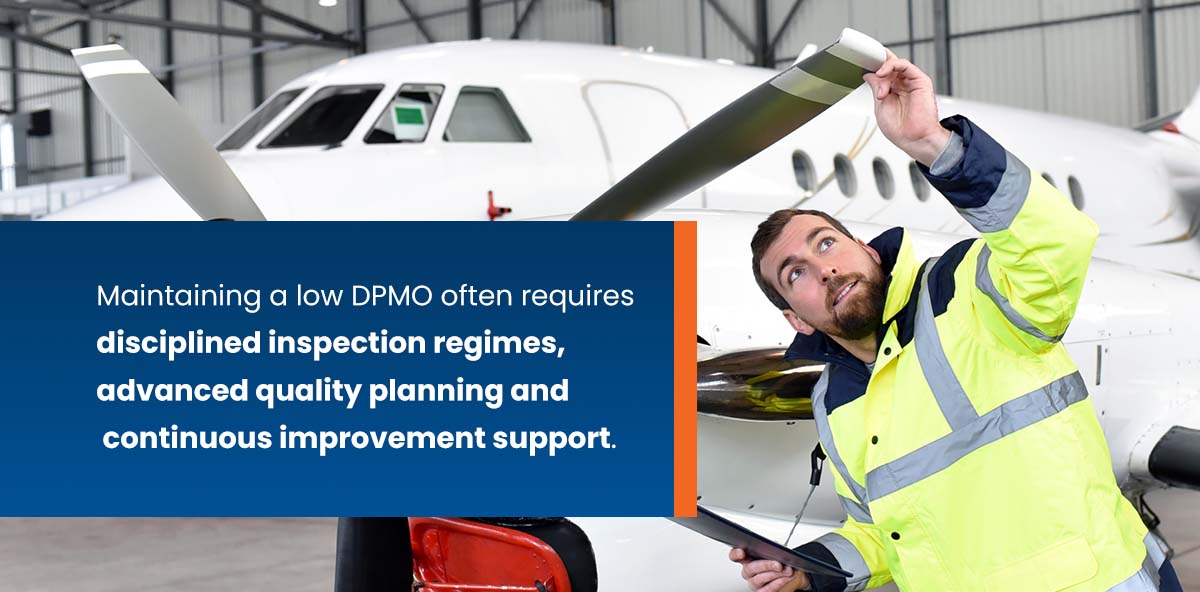Quality metrics turn complex operations into actionable intelligence. They enable practical risk management, faster corrective action and continuous improvement, all critical advantages in high-value manufacturing (HVM).
Aerospace and defense (A&D) manufacturers face strict standards, complex supply chains and costly compliance demands. Without precise data, rework and nonconformities drive up costs and jeopardize contracts. By tracking essential metrics, leaders gain visibility into production performance to maintain mission-critical quality. This approach strengthens customer trust and streamlines decision-making in high-stakes environments.
What Is Quality Management for Aerospace and Defense?
Quality Assurance (QA) in manufacturing serves many purposes. As a whole, it protects process conformity, program schedules, and reputations. QA also highlights alignment with key performance indicators (KPIs) and production part approval process (PPAP) standards.
In aerospace and defense, it must support complex supply chains, strict regulations and zero-defect expectations. Effective QA practices combine robust internal controls with independent oversight to ensure every component meets design intent and compliance requirements. These efforts help you maintain recognized certifications, such as:
- AS9100, a crucial quality standard for the aerospace industry
- AS9145, the PPAP standard for the aerospace industry
- ISO 9001, the general quality management system certification
- NADCAP accreditation, which covers special processes like coatings, welding and various forms of nondestructive testing
- ISO 17025, which covers testing competence and calibration laboratories
Without robust metrics and reporting, leaders often rely on assumptions. Minor deviations go undetected until they escalate into nonconformances, escapes and/or recalls. Compliance gaps can trigger penalties and result in certification loss. Rework and scrap increase costs, schedule and erode margins, while missed deadlines harm customer confidence and damage reputations. Poor data integrity also leads to legal exposure and can result in the exclusion of a program in the long term.
The Top 5 Quality Metrics Every Manufacturer Should Track
The right metrics provide early warning and objective insight into operations. They convert complex production data into clear action points.
In aerospace and defense, five metrics stand out for their ability to expose hidden risk, control costs and protect schedules. Each measures a different performance layer — delivery, process quality, supplier reliability, internal efficiency and compliance. Together, they create a balanced framework that drives continuous improvement and strengthens competitive standing.
1. First-Pass Yield
First-pass yield (FPY) measures the percentage of assemblies or products that meet specifications the first time, without rework. Using external product verification services supports the optimization of FPY. These services include:
- First article inspection
- In-process inspection
- Final inspection
A high rate signals stable processes and effective quality planning. Tracking this metric highlights areas where training, tooling or process control needs improvement. Implementing real-time data collection and statistical analysis systems supports faster problem detection and higher FPYs.
Every percentage point gained in FPY reduces rework hours, material scrap and delivery delays. High yield lowers unit cost and increases available capacity without new equipment.
2. Defects per Million Opportunities
Defects per million opportunities (DPMO) tracks defect rates with precision critical for aerospace reliability and compliance. Independent verification and inspection services give an early warning of process variation before it escalates into costly nonconformances.
Maintaining a low DPMO often requires disciplined inspection regimes, advanced quality planning and continuous improvement support. Integrated dashboards help identify trends and enable the targeting of interventions where they will have the most significant impact.
Each defect avoided prevents warranty claims, penalties and schedule slips. Low DPMO strengthens contract performance ratings and protects profit margins on fixed-price programs.
3. Supplier Quality Index
Supplier quality index (SQI) combines defect rates, delivery performance, responsiveness and audit scores into one metric. Supplier development programs and supplier audits help you manage supplier risk and align partners with stringent program requirements. Building a structured supplier index and conducting regular assessments drives improvement across the supply base. Independent audits, data analysis and supplier development programs further strengthen results.

Strong supplier scores mean the probability of fewer incoming defects and faster approvals. Improving SQI reduces expediting costs, mitigates supply chain risk and helps maintain program certifications.
4. Scrap and Rework Rate
Scrap and rework rates show the percentage of production effort lost due to nonconforming parts or processes. Tracking these rates through audit services and technical support for root cause analysis uncovers cost drivers and throughput barriers on the shop floor. Addressing high scrap or rework often involves root cause analysis, process capability studies and workforce training. Continuous monitoring with automated reporting tools helps reduce waste and boost FPY.
Scrap and rework consume hidden labor and material budgets. Lower rates free resources for growth initiatives and protect margins in tight-cost environments.
5. Audit Findings and CAPA Effectiveness
Audit findings and corrective and preventive action (CAPA) effectiveness measure how well an organization resolves and prevents nonconformances. They can be verified through in-process inspections and technical support, reducing risk and cost.
A low number of repeat findings and high CAPA success rates show thorough root cause analysis and good corrective action implementation. Structured internal audit programs, external assessment and CAPA tracking tools help sustain improvements and protect certifications. Embedding these practices into daily operations creates lasting compliance and regulatory inspection readiness.
Effective CAPAs reduce repeat issues, cut audit preparation time and safeguard certifications. Strong audit results verify process compliance and reduce certification and / or regulatory exposure.
Best Practices for Quality Assurance
A robust QA program goes beyond inspection. It embeds quality into every stage of production and the supply chain:
- Product verification: Use documented inspection plans, calibrated equipment and statistical sampling to confirm each unit meets specifications before shipment.
- Supplier audits: Conduct regular on-site and remote assessments to validate traceability and compliance with contractual standards.
- Supplier development programs: Partner with critical suppliers to improve process capability, training and corrective actions based on objective metrics.
- Technical support: Provide engineering and quality expertise to resolve nonconformances quickly, reduce process variation and accelerate certification readiness.
- Integrated data systems: Use real-time dashboards to track FPY, DPMO, SQI, scrap and CAPA effectiveness across plants and suppliers.
Get Quality Results From Unitek Technical Services
Combining rigorous internal controls with third-party oversight creates a resilient quality system. It allows manufacturers to sustain high performance on the metrics that matter most to aerospace and defense customers.
At Unitek Technical Services, we have extensive experience with QA in the aerospace and defense industries, offering over 45 years of experience. We use unparalleled resources, including engineers, project coordinators and quality specialists, to support your needs. To meet your quality management system requirements, we rely on strict compliance with prescribed standards.
Contact us today for reliable and consistent QA testing.

